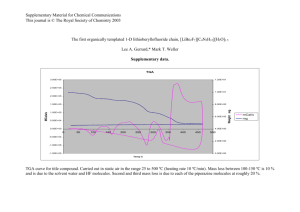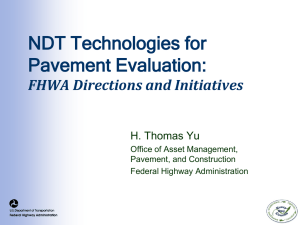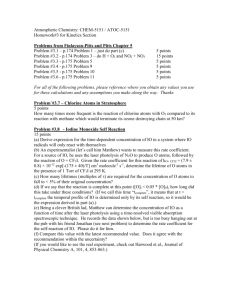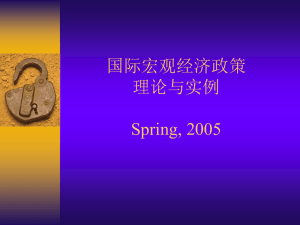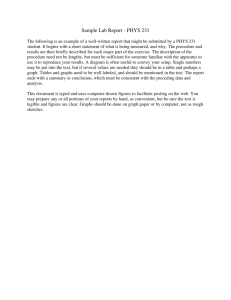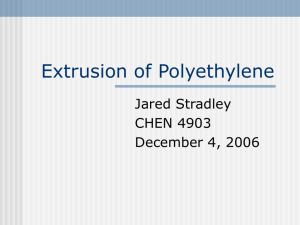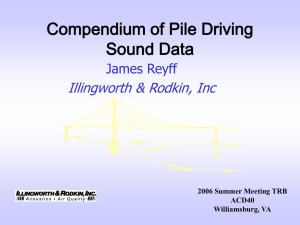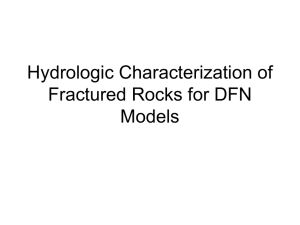Biochemistry 452 - Department of Molecular and Structural
advertisement
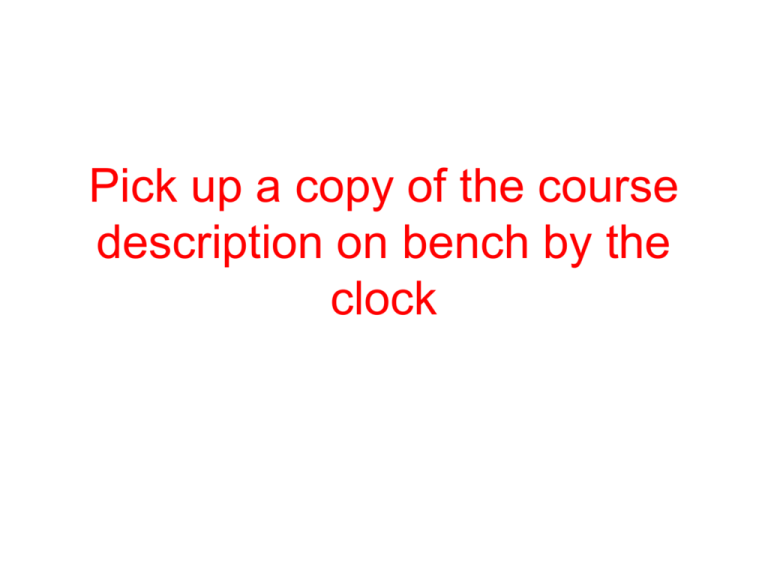
Pick up a copy of the course description on bench by the clock Biochemistry 452 Dennis T. Brown Room 346 Polk Hall Phone 515 5765 E-mail: dennis_brown@ncsu.edu Graduate TA: Both sections Gabriela Schroder gcschrod@ncsu.edu E-mail • Major mechanism of communication – Notify you of changes in schedule and project – Send updates on experiment results – Answer your questions • Keep your mail box clean – Lecture notes on web as too large to send – Some Mails may still push you over quota Lab Text • BCH 452 “Experimental Biochemistry, by Hardin-Ascencio-Knopp, Kendall-Hunt Eds. ISBN 978-1-4652-1311-2. Available at the University Bookstore or at Amazon.com (http://www.amazon.com/ExperimentalBiochemistry-HARDIN-CHARLES Lecture Notes and other info posted on Biochemistry web • http://biochem.ncsu.edu/faculty/brown/bro wn.php • At top near photo click on “Biochemistry 452 Notes” • Look at Powerpoints prior to lab Schedule • Lab opens at 1:15 – Turn in Pre lab questions & lab reports – Collect any handouts • 1.30 lecture • 2:00 lab exercise • Finish usually around 5:00 NO MAKE UP LABS • Late assignments without a valid excuse will not be accepted and will receive a score of zero. • Incomplete as a course grade will be awarded only for work not completed during the course due to conditions deemed by the instructor to be beyond the reasonable control of the student. • Attendance to all laboratories is mandatory and unexcused absences will affect the outcome of the course. Bch 452 • Will introduce fundamental techniques in biochemical analysis • Will teach the principles upon which the technology depends • Will make you familiar with theory and practice of the technology More Importantly BCH 452 • Will stress proper laboratory technique – Reproducibility – Eliminate errors • Will stress proper record keeping and data reporting – Necessary for archival considerations – For intellectual property – For trouble shooting Concept of 452 • Teach techniques in common use in biochemistry laboratory science • Try to present situations that exist in a real laboratory situation – Move from “exercises” with predictable outcomes. – To “experiments” with doubtful outcomes • Important to understand and explain anomalous results My Job • To be certain that you understand the principles that the experiments will examine • To be certain that you understand how the apparatus employed in the experiment functions • To be certain that you understand the reason for each step in the experimental protocol Lab Safety (Page XXIII) • • • • • • • • Students are expected to observe proper laboratory procedures as described in the lab manual (Page XXVII) a. This is a serious aspect of lab science. Go through the list in the manual. b. Read each laboratory experiment before you come to class. c. Follow precautionary statements given in each experiment. d. Only necessary work materials should be at or on the laboratory bench. Do no place coats, backpacks, or other personal belongings on your lab bench; store them in the lab cabinets or on the coat rack. Do not place them on the floor. e. Do not eat, drink, smoke or place materials in your mouth while in the laboratory. f. Wear appropriate clothing and eye protection while in the laboratory and experiments are in progress NO OPEN TOE SHOES g. Report all accidents to the instructor or TA immediately: such as spills, cuts, burns, or contact between reagents and your body or eyes. Take appropriate steps in an emergency situation (such as the use of the eye wash station or emergency shower). Hazardous materials • • • • • Hazardous reagents Volatiles Corrosives Mutagens Material Safety Data Sheets (MSDS) – Important information regarding all chemicals – Example on page XXV Model Molecules • The three major classes of biomolecules – Carbohydrates – Proteins – Nucleic acids Model Techniques • • • • • • Spectrophotometry Centifugation Chromatography Electrophoresis Biochemical fractionation PCR Your Responsibility • Read the experiment before you come to lab – Read pertaining sections of appendix – Read “Info Boxes” • Turn in the pre lab exercise • Have all required materials • Some of the protocols can be confusing. Make a flow sheet that outlines the steps. Grading • • • • • • • • • • Lab reports: 130 total points Pre Lab Questions: 33 points Exams (2): 25 points each Total 216 points A+ 216 - 205 C+ A 204 - 194 C A- 193 - 184 CB+ 183 - 173 D B 172 - 162 F B- 161 - 151 150 - 140 139 - 130 129 - 119 118 - 108 107 - 0 Extra Credit • 1. An extra 10 points is added to the Protein Purification and Southern blot Lab reports due to increased write-up requirements. • 2. Lab C1: 5 points extra credit for Arrhenius plot and activation energy calculation (see page 94) • 3. 7 extra credit points possible for a well-kept lab note book Reporting • Prelab questions – Clearly indicated (see page 28 for next weeks lab) – Due at beginning of designated lab • Ensures that you have read and understand the exercise • Completed report – Due at beginning of next exercise • Report for Lab A1 due at start of lab C1 Laboratory Notebook (ideal) See Page 3 • • • • • No loose pages Generates copies All entries dated Each page dated Pages signed by a witness attesting to date (extreme) Why?? • Retention time (7 years) Why ?? Lab Reports (Page 4) • Should contain • Statement of purpose – Why you are doing experiment – What you wish to determine • Brief account of theory and design of experiment – Summary or flow chart • • • • The raw data All calculations Results Conclusions and interpretation A form for lab write up in lab manual • Title all sections – Abstract, Discussion, Graph Titles etc. • Abstract should contain a concise summary of experiment – “I investigated the effect of temperature on activity of the enzyme Stickase by monitoring its ability to convert stick to broken stick. This was done by determining the accumulation of broken stick by spectrophotometry (A260) at temperatures between 10 to 60 degrees C. I found that Stickase converted stick to broken stick most efficiently at a temperature of 37oC” Lab Report • Record all your experimental data including changes in protocol • Label co ordinates. Be careful with units, spelling and grammar • Explain sources of error – It is not as important that you get a “correct” outcome as it is that you can explain your result. Remember • Your lab report is your PERSONAL representation of experimental results • Because you work in groups the raw data produced will be identical however your report should be distinct. Things that you should know Units of Biochemistry • Decade system – Moles – Meters – Liters – Grams – Centigrade Elementary calculations • • • • Gram Molecular Weight Dilutions Rate equations “What is the molar concentration of a solution that is 5 millimolar NaCl” Significant Figures • Determines the value of a data set • Includes estimations – 3.2 is not the same as 3.20 or 3.200 Presentation of Data • Data tables • Graphs A Table or Graph Should: • Be easy to understand • Project a message • Does not require extensive reference to text Experiment • A solution of compound X is reacted with reagent Y which causes the production of a light absorbing product. The amount of light absorbing product indicates how much compound X is present. The sample containing X is divided into three aliquots and the experiment is repeated three times at three wavelengths. Lousy Table Results of the three experiments Absorbance values for reaction #1 at 360, 420 and 540 nm Absorbance values for reaction #2 at 360, 420 and 540 nm Absorbance values for reaction #3 at 360, 420 and 540 nm 0.875 (360) 0.885 (360) 0.823 (360) 0.253 (420) 0.250 (420) 0.244 (420) 0.164 (540) 0.165 (540) 0.157 (540) Good Table Absorbance values for the “experiments” at 360,420 and 540 nm Trial # A360 A420 A540 1 0.876 0.253 0.164 2 0.885 0.250 0.163 3 0.825 0.244 0.157 Bar Graph A: Compares Values at each wavelength, Shows Reproducible 0.9 0.8 0.7 0.6 0.5 Absorbance 0.4 0.3 0.2 0.1 0 Trial 1 Trial 2 Trial 3 A360 A420 A540 Wavelength Bar Graph B: Compares absorbance at different wavelength, shows sensitivity 0.9 0.8 0.7 0.6 0.5 Absorbance 0.4 0.3 0.2 0.1 0 A360 A420 A540 Trial 1 Trial 2 Trial 3 What is an “Experiment” An example from our research program Dr. Raquel Hernandez: Research Associate Professor Biochemistry Experiment • • • • • • • Theory Hypothesis to test theory Experiment suggested by hypothesis Design of experiment Result of experiment Conclusions and expansion of experament Translation to practical application Fact &Theory • Arthropod borne viruses (ArBoViruses) – A class of medically important viruses that are carried in nature by mosquitos • Dengue virus infects 500million people/year. 3billion at risk (40% worlds population). • No treatment or cure • Theory: Arboviruses are insect viruses which have evolved over millions of years to infect vertebrates Hypothesis • As they evolved to infect vertebrates, Arboviruses acquired new genetic information necessary for growth in this completely different genetic and biochemical environment • It should be possible to identify those genetic elements and remove them – Produce virus which can grow in insects but not vertebrates Virus Structure as a Target Outer shell, 2 proteins Membrane bilayer. Is penetrated by the two proteins in the outer shell Core. Contains multiple copies of one protein surrounding RNA Sindbis Virus Envelopment E2-E1 Trimer Mammalian and insect membranes • Insect membranes have no cholesterol • Cholesterol makes membranes viscous, ion impermeable and thick • Insect membranes are 4 nm thinner than vertebrate • Membrane protein must span both insect and mammalian membrane Vertebrate Wild Type Insect Deletion Mutant Sindbis Virus Glycoproteins Systematically remove amino acids from transmembrane domain E2-Capsid Binding Domain E2 Transmembrane Mutants VYTILAVASATVAMMIGVTVAVLCAC Wild Type (TM26) VYTILAVASATVAMMIGVTVAVLCAC TM25(D379M) VYTILAVASATVAMMIGVTVAVLCAC TM24 VYTILAVASATVAMMIGVTVAVLCAC TM23 VYTILAVASATVAMMIGVTVAVLCAC TM22 VYTILAVASATVAMMIGVTVAVLCAC TM21 VYTILAVASATVAMMIGVTVAVLCAC TM20 VYTILAVASATVAMMIGVTVAVLCAC TM19 VYTILAVASATVAMMIGVTVAVLCAC TM18 VYTILAVASATVAMMIGVTVAVLCAC TM17 VYTILAVASATVAMMIGVTVAVLCAC TM16 VYTILAVASATVAMMIGVTVAVLCAC TM14 VYTILAVASATVAMMIGVTVAVLCAC TM12 VYTILAVASATVAMMIGVTVAVLCAC TM10 VYTILAVASATVAMMIGVTVAVLCAC TM8 Hernandez et al. J Virol. 2003 Dec;77(23):12710-9. Growth of TM mutants in mammalian and insect cells 1.00E+10 1.00E+09 1.00E+08 1.00E+07 1.00E+06 1.00E+05 1.00E+04 1.00E+03 1.00E+02 1.00E+01 1.00E+00 20 25 HR SV Y4 TM 24 23 22 21 20 19 18 17 16 14 12 10 8 TM16 & TM17 are host restricted mutants TM TM TM TM TM TM TM TM TM TM TM TM TM Mutant Conclusions • Shortening transmembrane domain crates a host range (HR) mutation – Restricts efficient growth to insect cells • Suggests approach for making vaccines for arboviruses – Use HR mutants as vaccines Vaccination of mice with TM16 and 17 GROUP (12 Mice) VIRUS s.c. DOSE PFU MORBIDITY 1 Mock (buffer) NA 0% 2 TM16 106 3 TM16 UV 4 5 MORTALITY CHALLENGE (14 days) MORBIDITY MORTALITY 72 hr POST CHALLANGE 72hr POST CHALLENGE PROTECTION Morbidity/ mortality 0% SAAR86 1000 pfu i.c. 11/12 5/12 8.3%/58% 0% 0% SAAR86 1000 pfu i.c. 8/12 6/12 33%/50% NA 0% 0% SAAR86 1000 pfu i.c. 11/12 4/12 8.3%/66% TM17 106 0% 0% SAAR86 1000 pfu i.c. 0 0 100%/100% TM17 UV NA 0% 0% SAAR86 1000 pfu i.c. 10/12 5/12 16%/58% TM 17 provided complete protection from challenge Patent Strategy US Patent No. 6,589,533 Issued July 8, 2003 "Genetically-engineered alphaviruses, flaviviruses, and bunyaviruses with modified envelope transmembrane glycoproteins and altered host-range phenotype" US Patent No. 6,306, 401 Issued October 23, 2001 "Genetically-engineered sindbis virus with modified E2 Glycoprotein and altered host-range phenotype" US Patent No. 7,335,363 Issued February 2008 "Membrane Virus Host-Range Mutations and their use as Vaccine Substrates" Three other patents pending This technology • Is a vaccine platform – All Arboviruses have the same transmembrane domain – This approach should work for all 700 known arboviruses • Create a company to move the technology to the marketplace – Originally “Arbovax” – Now “Vacunas” Products • Vaccine for Dengue Fever – Developed for all 4 serotypes – Very successful non humane primate trial • 100% Sero-conversion to all 4 serotypes – Ready for phase one human clinical trials • Approved by Food and Drug Administration • Vaccine for Chikungunya Fever – Successful trials in mice – Ready for non human primate trials • Vaccine for West Nile Fever – Host range mutants made – Ready for trials in mice Translational Science • From Theory (basic Science) to Medical Product (application) • Strategy will work for any of the 700 known arboviruses – 150 are known to cause human disease – Some cause disease in animals of agricultural importance Next Exercise • Carbohydrates and standard curve – Section A1 in lab manual (page 26) – Read carefully prior to coming to lab. – Do the pre lab questions turn them in on the 26th-27th Benchtop Protocols • Page 387 • The benchtop protocol summarizes step be step the days experiment. It is more convenient than having the entire manual open on your bench DVD • The DVD shows step by step each part of the experimental protocol, watching it will help prepare you for the days exercise

